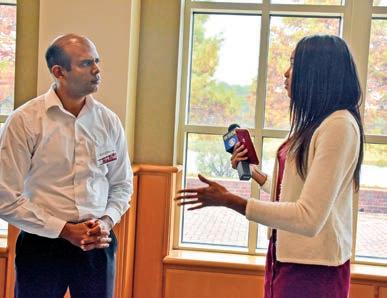Exploring Potentials of Bioactive Phosphopeptide Production from Phosvitin in Hen’s Egg Yolk as a Novel Functional Ingredient Developing value-added products from egg yolk will increase its value and utilization and therefore improve the sustainability of the U.S. egg industry. Although the consumption of processed egg products has considerably increased, egg yolk has Dr. Byungrok Min been underutilized because of consumer health concerns regarding its cholesterols and lipids. Consequently, novel ways to increase the utilization of egg yolk should be developed. Phosvitin is one of the major egg yolk proteins and has a great amount of potential to produce bioactive phosphopeptides that
Potential Availability of Urban Wood Waste Stream: Their Conversion to Platform Chemicals for the Synthesis of Novel Bioenergy/ Bioproducts in Maryland
Dr. Yeong Nain Chi
Urban forest/wood waste-streams (UFWWS) in Maryland represent potential raw material sources for producing platform chemicals that can be converted to higher value-added products for its emerging bio-economy.
Research Briefs can be utilized as novel functional ingredients in food, nutraceutical, and pharmaceutical products. Because of their strong binding capacity to metal-ions such as calcium, iron, and magnesium and their inhibitory capacity against the formation of insoluble metal deposits, phosphopeptides can improve the intestinal absorption of nutritionally essential metal-ions. They also can prevent biomolecule oxidation and microbial growth in foods. However, the production of bioactive phosphopeptides in small sizes from phosvitin is challenging due to its structural characteristics. Recently, preliminary testing showed that the novel combination technology of the pressurized heat treatment and twoenzyme system could effectively produce small phosphopeptides from phosvitin. This is a breakthrough in phosvitin hydrolysis. The overall goal of the project is to determine the potentials of the production of bioactive phosphopeptides from phosvitin, using the novel technology and its applicability as nutraceutical, cosmeceutical, or pharmaceutical agents. The results will be used to develop a research proposal for the USDA/NIFA-AFRI program that involves scale-up manufacturing and the evaluation of the health benefits associated with egg yolk. This work is supported by the Agriculture and Food Research Initiative, Grant No. 2019-67018-29185, from the USDA National Institute of Food and Agriculture. The current practice of landfilling urban/wood waste-streams is expensive (tipping fees) and eventually results in long-term environmental problems. Further, current products from this resource are high-volume, low-value products such as landscape mulch, soil conditioner, animal bedding, compost additive, etc. A multidisciplinary collaborative research effort between UMES and a scientist from West Virginia University’s Division of Forestry and Natural Resources will address this problem through the following objectives: a) estimate available UFWWS in 60 towns/ cities in Maryland; and b) develop alternate low-volume, high-value novel bioenergy/bioproducts from these waste-streams to meet Maryland’s emerging bioeconomy market. This proposal responds directly to the research needs of foresters, arboriculturalists, natural resource managers, researchers and directly addresses one of the high priority areas of the Capacity Building Grant Program - bioenergy/biofuel and natural resources. The proposed research seeks to upgrade the research capability of the urban forestry program at UMES by providing experiential research training to undergraduate and graduate students and a post-doctoral fellow. Findings from this research will be distributed through several mechanisms: fact sheets, poster and conference presentations, refereed journal articles, the UMES urban forestry website, and to stakeholders (Maryland Department of Natural Resources, arborists, forest products utilization companies, etc.). This work is supported by Capacity Building Grant Program, Grant No. 2019-38821-29294, from the USDA National Institute of Food and Agriculture. INGENUITY | SPRING 2020
3














